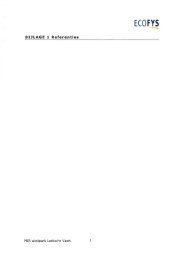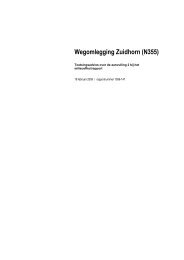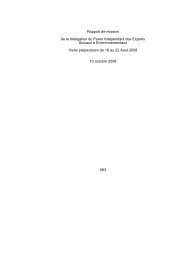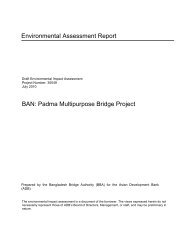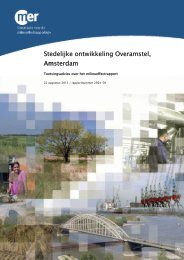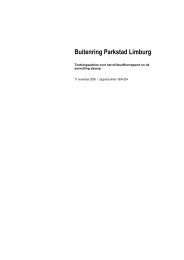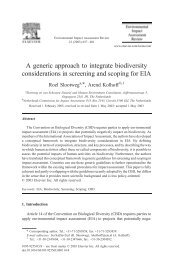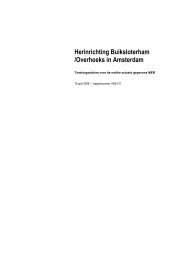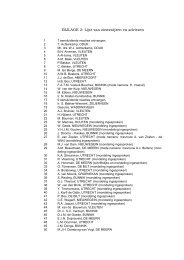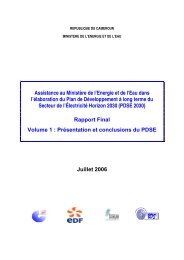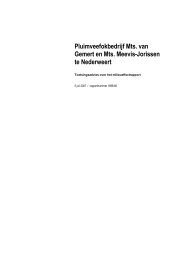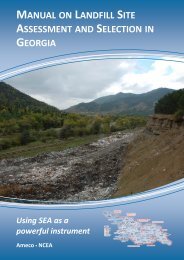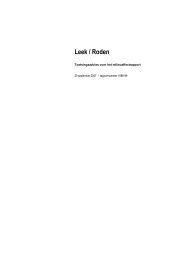Scoping Advice for the Dutch IWRM Support Programme Rwanda
Scoping Advice for the Dutch IWRM Support Programme Rwanda
Scoping Advice for the Dutch IWRM Support Programme Rwanda
You also want an ePaper? Increase the reach of your titles
YUMPU automatically turns print PDFs into web optimized ePapers that Google loves.
4. Do a consistency analysis: new versus existing objectives5. Set ToR <strong>for</strong> <strong>the</strong> technical assessment, based on scoping resultsA pro-active SEA can be used to identify stakeholders, <strong>for</strong> example based on an inventory ofwater related ecosystem services, that are invited to discuss <strong>the</strong> development opportunitiesand constraints of a catchment. To ensure buy-in, <strong>the</strong> NCEA would recommend this approach.In Figure 1 (see ‘in conclusion’ below) an example is given of a stepwise approach to proactiveSEA focussed on identification of development constraints and opportunities, or a reactiveSEA focussed at identifying impacts of alternative catchment plans.Depending on <strong>the</strong> issues at hand in a specific catchment, various sector policy documentsmay be relevant. In principle <strong>the</strong> Master Plan has already addressed <strong>the</strong> consistency betweensector policies, but as stated earlier, fur<strong>the</strong>r refinement of <strong>the</strong> in<strong>for</strong>mation base at catchmentlevel is an absolute necessity. The same applies to a fur<strong>the</strong>r detailed analysis of <strong>the</strong>consequences of sector policies at catchment level.Assessment6. Assess <strong>the</strong> impacts of alternatives and document this7. Organise (independent) quality assurance of documentationAt <strong>the</strong> end, this ToR contains an example from South Africa how a catchment assessment,based on an inventory and valuation of ecosystem services, provides in<strong>for</strong>mation <strong>for</strong> planners.The status of ecosystem services defined whe<strong>the</strong>r <strong>the</strong>re was room <strong>for</strong> fur<strong>the</strong>r development orwhe<strong>the</strong>r <strong>the</strong> status of a service would already require management interventions.Oversight on <strong>the</strong> process, including quality assurance, is a <strong>for</strong>mal task of REMA. NCEA canplay a role in coaching <strong>the</strong> process on procedure as well as contents. Alternatively, it could beasked to review its quality, whichever role is preferred by <strong>the</strong> SEA owner and/or REMA.Decision making8. Discuss with all stakeholders <strong>the</strong> alternative to prefer9. Motivate <strong>the</strong> (political) decision in writingMonitoring10. Monitor <strong>the</strong> implementation and discuss <strong>the</strong> resultsLinking <strong>the</strong> SEA monitoring requirements with <strong>the</strong> monitoring activities under <strong>the</strong> EKNcapacity development support programme provides an effective mechanism to guarantee <strong>the</strong>necessary follow up to <strong>the</strong> SEA process.42 OECD-DAC Good Practice Guidance in Applying SEA in Development Co-operation, see also Appendix 9.40



